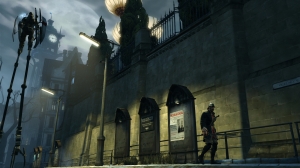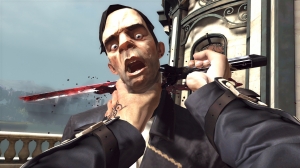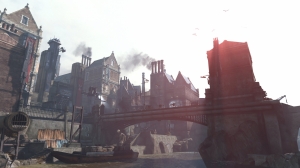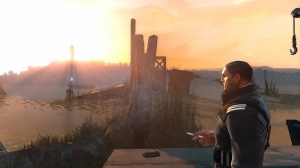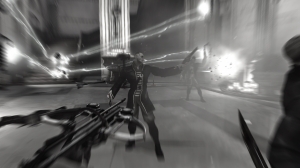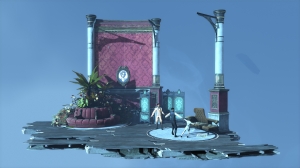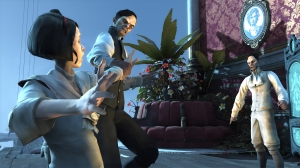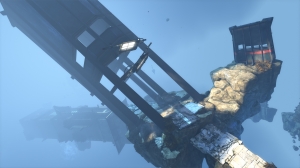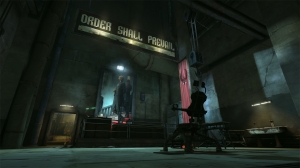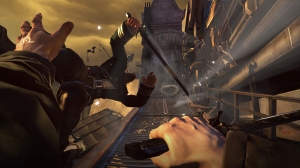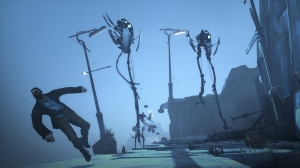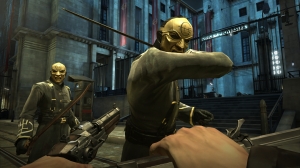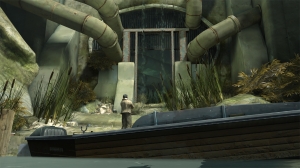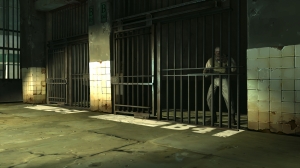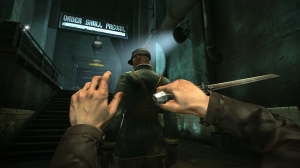 Dishonored is a new intellectual property from the developers at Arkane Studios. This is the studio behind the games Arx Fatalis and Dark Messiah of Might and Magic. Arx Fatalis, released in 2002, showed the studios depths in being able to create a deep role-playing game. Four years later, Dark Messiah of Might and Magic showed off the studios ability to create a satisfying and engaging combat system. Despite both of these games not breaking through to triple-A status, Arkane Studios has shown they have what it takes to create games with depth and more importantly, games that are enjoyable to play. It’s not hard to see that Dishonored comes from a very competent pedigree but can they elevate it to the next level?
Dishonored is a new intellectual property from the developers at Arkane Studios. This is the studio behind the games Arx Fatalis and Dark Messiah of Might and Magic. Arx Fatalis, released in 2002, showed the studios depths in being able to create a deep role-playing game. Four years later, Dark Messiah of Might and Magic showed off the studios ability to create a satisfying and engaging combat system. Despite both of these games not breaking through to triple-A status, Arkane Studios has shown they have what it takes to create games with depth and more importantly, games that are enjoyable to play. It’s not hard to see that Dishonored comes from a very competent pedigree but can they elevate it to the next level?
The story starts off with the main character, Corvo Attano, returning from a journey to neighboring islands asking for help. In your state of Gristol, there is an emerging problem with a rat plague that consumes victims and turn those who survive into mindless zombies called weepers. Regrettably, the news you bring back to the Empress is grim. None of the other civilizations nearby have dealt with this issue and there is no known cure yet. While reporting your news, you notice all the guards magically are nowhere to be found. Mysterious men appear out of thin air and you try your best but it’s not enough, they succeed in assassinating the empress and kidnapping her daughter. On top of it all, you are blamed for it and sentenced to death. Luckily, before your date with die comes, help from a mysterious group arrives and enable you to enact vengeance on the people who killed your empress, kidnapped her daughter, and stole the throne. It’s easy to see how this play will twist and turn but the star of the story is really the world. It serves up some great set pieces for assassinations and littered with small details that add to the richness of the world. For those who want more, there are books and letters to read as well. While you may see the broad strokes of the story and through your actions, even change it in some ways, it’s really the set pieces and details that make the world an interesting and unique world to visit.
Dishonored is a first-person action game that pits you in the role of a protector turned assassin. The game is broken up into missions. Each mission has a main task to accomplish, typically an assassination but it rarely ever has to end in death. The game allows for you to tackle everything in nonlethal and interesting ways. Multiple paths through the levels ensure that you can avoid conflict if you desire. There is always a nonlethal way to deal with your target which is typically much more involved than a simple keystroke. And this fundamental choice through the game constitutes a large aspect of a morality system. If you go through the game killing, even silently, you will accrue chaos. More chaos will change the world in slight ways such as new environmental hazards, people looking at you in a different way and of course a different ending. The biggest issue with the chaos system is that you actively have to try to be nonlethal. Sneaking through the game and engaging the enemy only in times of being detected will put you on the road to high chaos. There is an evaluation screen at the end of each level letting you know how you did but other than a text saying what your overall chaos is, you have no indication of how you are affecting it. So if you waste the first level or two wrecking havoc and try to push the rating back to low on the next, it’s very likely that it remains at high. I wish there was a visual meter showing how your actions on that level moved it one way or the other to reward your work.
To tackle this choice, the game provides you with a variety of tools. The first of which is your innate abilities. If you want to take the high road, you can crouch and sneak, taking down enemies silently from behind and hiding their bodies. Or you can do straight up combat with your sword and assassinate people. Either way works great and is satisfying. The combat system has a little depth with having to time attacks and blocks. If you execute a block at the right time, you can quickly assassinate them. Taking on one or two enemies is not a problem for Corvo but once they start piling on, it’s time to run away. On top of this foundation are weapons and powers. The weapons you gather through the game never replace your sword, the fit into the category of projectiles, traps, and grenades. Some are for nonlethal takedowns but most are for causing death. Part of the issue with combat is that nonlethal and lethal do not demand equivalent skills. Killing people is much more easy and satisfying as long as you don’t take on too many people. So you will sneak up until the point you get detected and then strike like a panther in the dark. It’s a very satisfying way to play but if you want to keep your chaos rating low for a different affect on the world, you’ll have to work a little harder than those who want to gravitate to killing.
The other dynamic to combat are the powers. They come in two varieties, active and passive powers. Throughout the world, runes are located to be found or as rewards for quests. You use these to purchase the better powers, or upgrade them to a more powerful tier. They include Blink, which is awesome skill for exploration. It allows you to jump a short distance to a spot of your choosing. There is another skill for possessing animals which allow you to enter storm drains to enter locations undetected. They are diverse and help enable whichever style of play you wish to pursue. The other style of power is called bone charms. They act similarly to Call of Duty’s perks, they slightly augment one aspect of the game and you can enable several at a time. Powers are an enjoyable way to reinforce your chosen play style, especially since they are open to be purchased from the beginning. I wish runes and bone charms were a little harder to find though, perhaps even hidden behind more puzzle platforming gameplay. In the beginning, you get an item that when you equip it, gives the exact pinpoint locations of all the runes and bone charms in the level and with certain powers, makes retrieving them quite trivial. Some do require some thinking or finding a key but they are few are far between.
Overall the game feels really solid. You will seamlessly use powers and weapons in conjunction with your sword. The commitment to the possibility of a nonlethal playthrough is admirable. There are always options in how to approach a situation. The missions are varied and for the main targets, there is usually always an interesting way to tackle them without resorting to killing. It must be noted that taking the nonlethal approach will drastically increase your difficulty in comparison to just killing your foes. In addition to this, the chaos morality system is shrouded in a bit of a mystery. Sure it’s easy to know how it works but it’s not easy to see how you’re affecting it from level to level so you can feel like you can redeem your actions and get back to low chaos. Dishonored can be called similar to some games but when you can into account all the elements at work here, it’s quite a unique and polished experience.
The graphics in Dishonored are definitely special. The style is like a dark old oiled painting of a dystopia Victorian-era England. The look really works well and amazing considering that it’s running smoothly on the Xbox 360. The levels are quite open but you’re confined to an area, similar to Bioshock and the new Deus Ex. You are connected between areas via doors or other mechanisms for loading. With certain powers, your ability to explore is exponentially better but with some of the levels are made, you’ll be butting your head against the invisible walls quite quickly. While this does sound limiting, the way the levels are created, there are a myriad of pathways to explore and follow. It seems not only a graphical choice but also gameplay, as running across rooftops in certain instances would feel like cheating. The other issue is that while the look is pulled off, some textures can feel low-resolution. Especially the time where you’re told to look for details in paintings. Some may find faces to look weird but I believe that’s just the art style and not a graphical limitation. Overall, you’re in store for a unique and beautifully dark visual experience. Some things could be better but it’s amazing that even this level of graphical fidelity is running on such an old system.
The sound design is something you may not immediately notice. It’s really well done but it sort of sits in the background and seamlessly fits into the game. When you assassinate someone, the sound is incredibly satisfying as you gut them. The voice acting is great with one notable exception, that the player character is silent. There are times, especially at the beginning when you’re accused, you just want to shout at the screen in your defense, yet you remain silent. The soundtrack is another element where you won’t really remember much at the conclusion of the title but when you listen to it outside of the game, you remember it. You remember how well it seamlessly seeped into and out of the gameplay experience. The sound design may be not that noticeable or memorable, but it adds a great deal to the title.
Dishonored is a wonderful title. The fluidity of the gameplay allows for you to pull off a lot of cool things. The focus on making stealth and nonlethal approaches is admirable. You always feel like you have several options to tackle a particular scenario via multiple paths, sneaking, and versatile powers. On the other hand, combat feels fun and enjoyable. The best way to play I found was one of stalking in the shadows, avoiding the large groups and picking off the stragglers. It’s a very enjoyable experience. The story is crafted from a familiar theme but with the wonderful setting, the developers had a lot of fun bringing life to the world. You’ll probably see the broad strokes of the story but the little details is what make the story quite enjoyable. The graphics definitely heighten the experience. The game is set in a Victorian-era dystopian society where everything looks like a grim warped painting. Some levels can feel a little small when trying to make the full use of your powers though and textures can look low detail at times. The subdued sound design works well for building atmosphere and tension but isn’t that memorable. It seems more to serve the total experience than to stand out. The gameplay and set pieces help set the tone for an awesome experience. While it is single player only, the content here is meaty and has a healthy dose of replayability. The gameplay is great and the world is masterfully crafted. You owe it to yourself to step into the shoes of Corvo and experience one of the more unique titles of this year.
Gameplay
Graphics
Sound
Overall
Screenshots:

